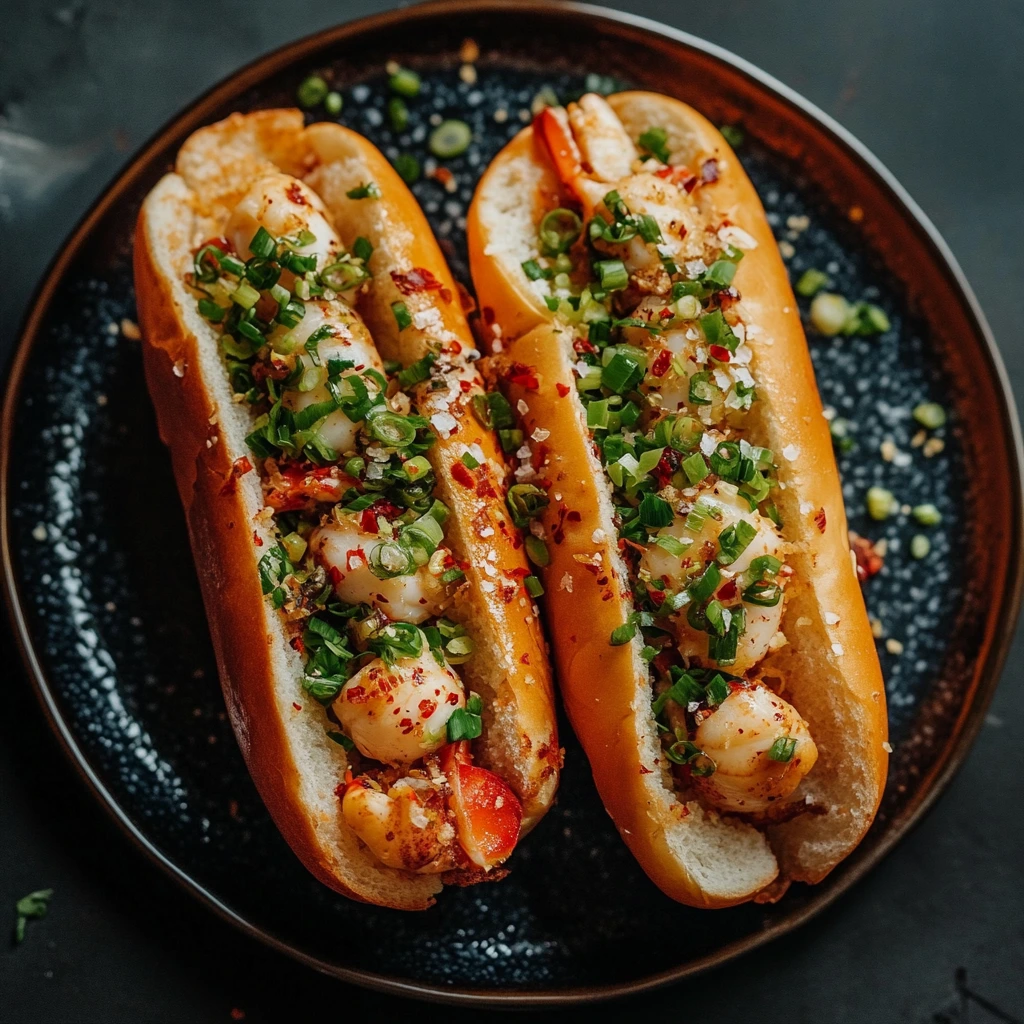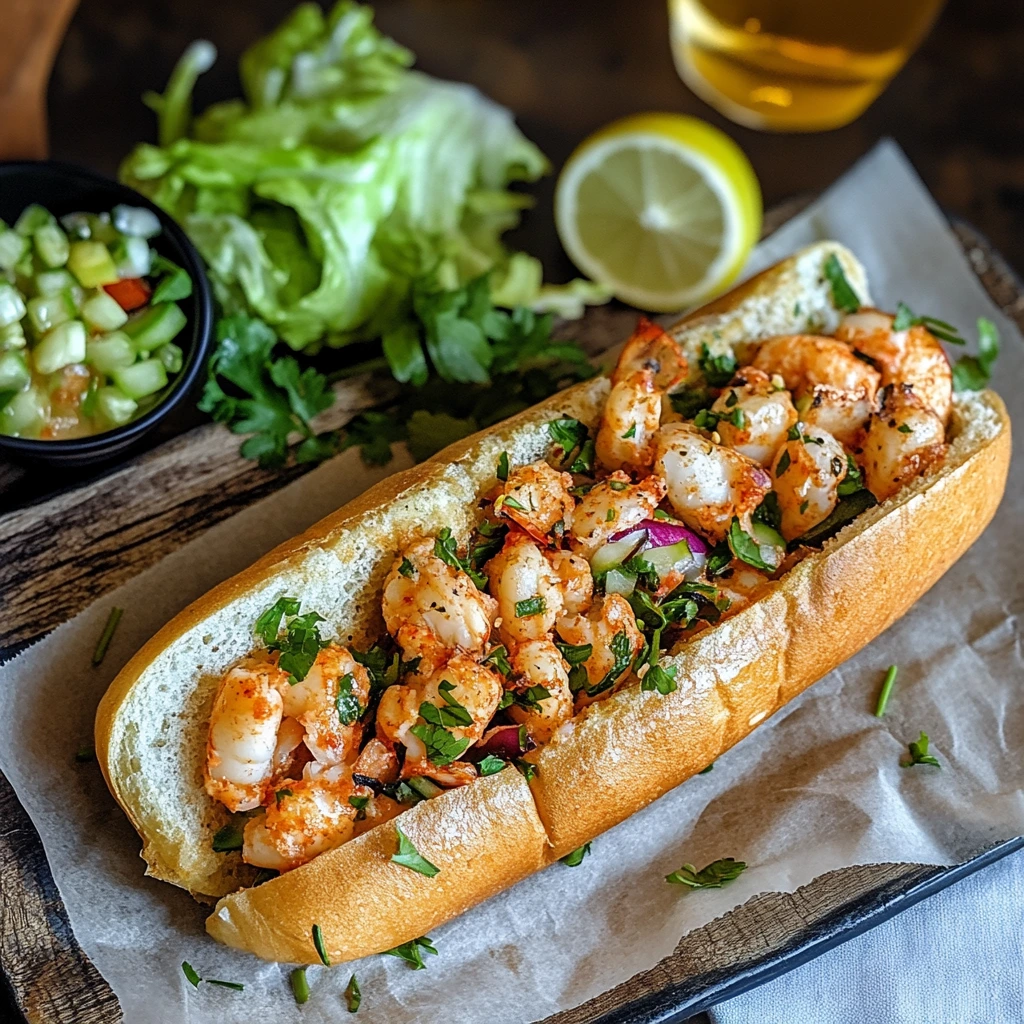A lobster roll is the ultimate New England classic, beloved for its buttery, tender lobster meat served on a perfectly toasted bun. If you’re searching for a great Lobster Roll recipe, this iconic sandwich is a staple in coastal seafood shacks, where fresh Maine lobster is transformed into a simple yet irresistible dish.
There are two main styles of lobster rolls: the Maine-style, which features chilled lobster mixed with a light mayonnaise dressing, and the Connecticut-style, where warm lobster meat is drenched in melted butter. Both versions are delicious, offering a rich, sweet lobster flavor complemented by a soft yet crispy bun.
Whether you’re enjoying a lobster roll by the beach or making one at home, mastering this easy lobster roll recipe will bring a taste of the coast to your kitchen. In this guide, we’ll cover everything from choosing the best lobster meat to assembling the perfect lobster roll, along with tips for serving and pairing this seafood favorite. Let’s dive in!

What Makes a Classic Lobster Roll?
Maine vs. Connecticut Lobster Roll – What’s the Difference?
Both Maine-style and Connecticut-style lobster rolls feature fresh lobster in a toasted bun, but they differ in temperature and ingredients.
Maine-Style Lobster Roll (Cold & Creamy)
- Chilled lobster meat mixed with mayo, lemon juice, and celery.
- Served in a buttered, toasted split-top bun.
- Light seasoning to enhance the lobster’s natural sweetness.
- Refreshing and ideal for warm weather.
Connecticut-Style Lobster Roll (Warm & Buttery)
Perfect for those who prefer a savory seafood experience.
- Warm lobster meat tossed in melted butter (no mayo).
- Served in a buttered, toasted split-top bun.
- Focuses on rich, buttery lobster flavor.
- Perfect for those who prefer a savory seafood experience.
Key Ingredients for the Best Lobster Roll
A great lobster roll starts with fresh ingredients and simple, balanced flavors. Here’s what you need:
1. Fresh Lobster Meat
- Maine lobster is best for its sweet, tender meat.
- Use claw, knuckle, and tail meat for the best texture.
- Aim for 4-5 ounces per roll for a generous serving.
2. The Perfect Bun
- A New England-style split-top hot dog bun is ideal.
- Butter and toast it for a crispy, golden-brown finish.
- Brioche or regular hot dog buns can be substitutes.
3. Dressing – Mayo or Butter?
- Maine-style: Lightly tossed in mayo, lemon juice, and celery.
- Connecticut-style: Warm lobster drenched in melted butter (no mayo).
4. Simple Seasonings
- Salt, pepper, and lemon juice enhance the flavor.
- A sprinkle of chives or parsley adds freshness.
- Old Bay seasoning is optional for extra depth.
A well-toasted bun, fresh lobster, and balanced flavors make the perfect lobster roll. Keep it simple and enjoy this New England classic!

Step-by-Step Guide to Making the Best Lobster Roll
Preparing the Lobster Meat for Maximum Flavor
The secret to a perfect lobster roll is tender, flavorful lobster meat. Whether using fresh or frozen lobster, proper preparation is key.
1. Choosing the Best Lobster Meat
- Maine lobster is the best choice for its sweet, tender texture.
- Use claw, knuckle, and tail meat for the best flavor.
- If using frozen lobster, thaw it overnight in the fridge.
2. Cooking the Lobster (For Live Lobsters)
- Steaming (Best for Tender Meat): Steam lobsters for 8–12 minutes, then place in an ice bath.
- Boiling (Quick Method): Boil for 7–10 minutes, then cool in ice water.
- Avoid overcooking to prevent toughness.
3. Removing the Meat
- Crack open the claws, knuckles, and tail to extract the meat.
- Remove the dark vein from the tail.
- Save shells for lobster stock.
4. Preparing the Meat for Lobster Rolls
- Maine-style: Chop meat into bite-sized pieces and chill before mixing with mayo.
- Connecticut-style: Keep meat in larger chunks and warm in melted butter before serving.
- A squeeze of lemon juice enhances natural sweetness.
5. Storage Tips
- Fresh lobster meat is best eaten within 24 hours.
- Store in an airtight container with a damp paper towel to prevent drying.
Assembling the Perfect Lobster Roll
A great lobster roll balances buttery toasted bread, tender lobster, and simple seasonings. Follow these steps for the perfect bite.
1. Toasting the Bun
- Use a New England-style split-top bun for soft texture and crisp sides.
- Butter the outsides and toast on a skillet until golden brown.
- Let it cool slightly before adding the filling.
2. Prepping the Lobster Filling
- Maine-style (Chilled & Creamy): Mix chilled lobster meat with mayo, lemon juice, and optional celery or chives.
- Connecticut-style (Warm & Buttery): Toss warm lobster meat in melted butter—no mayo.
3. Filling the Bun
- Gently open the toasted bun and add 4-5 ounces of lobster meat.
- Keep the filling mounded on top without overstuffing.
4. Final Touches & Serving
- Squeeze of lemon for brightness.
- Sprinkle chives, parsley, or Old Bay seasoning (optional).
- Serve with fries, coleslaw, or chips.

Tips & Tricks for the Ultimate Lobster Roll Experience
Best Sides to Serve with Lobster Rolls
A lobster roll pairs best with crispy, refreshing, or creamy sides that complement its rich, buttery flavor.
1. Crispy Classics
- French Fries – Classic, shoestring, or truffle fries.
- Sweet Potato Fries – A slightly sweet contrast.
- Potato Chips – Simple, salty, and crunchy.
- Onion Rings – Lightly battered for extra crispiness.
2. Light & Refreshing Sides
- Coleslaw – Tangy and crunchy (vinegar or mayo-based).
- Green Salad – With a lemon vinaigrette for freshness.
- Cucumber Salad – Cool and light with dill or lemon.
- Corn on the Cob – Buttered or grilled for a sweet touch.
3. Creamy & Comforting Options
- New England Clam Chowder – A warm, classic seafood pairing.
- Mac & Cheese – Rich and cheesy, perfect for indulgence.
- Potato Salad – Light, mustard-mayo dressing for balance.
4. Seafood-Inspired Additions
- Fried Clams – Crispy and briny.
- Steamed Mussels – Cooked in butter, garlic, and white wine.
- Shrimp Cocktail – Chilled shrimp with zesty cocktail sauce.

FAQs About Lobster Rolls
Can I Use Frozen Lobster Meat?
Yes! Frozen lobster meat is a great alternative to fresh lobster if handled properly.
1. Choosing Quality Frozen Lobster
- Opt for wild-caught Maine lobster (pre-cooked or raw tails).
- Avoid products with preservatives or freezer burn.
2. How to Thaw It Properly
- Best method: Thaw in the fridge for 12–24 hours.
- Faster method: Submerge in cold water, changing it every 30 minutes.
🚫 Avoid microwave or room temperature thawing.
3. Cooking Frozen Lobster for Rolls
- Maine-style (chilled): Thaw, chop, and mix with mayo and seasoning.
- Connecticut-style (warm): Lightly sauté in melted butter before serving.
- If using raw lobster tails, steam or boil before extracting the meat.
4. Does It Taste as Good as Fresh?
High-quality frozen lobster can still make delicious, tender lobster rolls when properly thawed and seasoned.

How Long Can a Lobster Roll Stay Fresh?
Lobster rolls are best eaten fresh, but proper storage helps maintain their quality.
1. Storage Time
- Room Temperature: 1–2 hours max, then discard.
- Refrigerated: Up to 24 hours, best stored separately.
- Frozen: ❌ Not recommended, ruins texture.
2. Best Storage Method
- Lobster Meat: Airtight container with a damp paper towel in the fridge.
- Bun: Keep at room temperature to prevent sogginess.
- Assembled Roll: Wrap in plastic wrap, but expect a softer bun.
3. Reheating Tips
- Maine-style (chilled): Let sit at room temp for 10 minutes.
- Connecticut-style (warm): Reheat lobster in melted butter and toast the bun separately.
4. Signs It’s Gone Bad
- Sour smell
- Slimy or discolored meat
- Moldy or overly soggy bun
For best taste, eat immediately or store properly for up to 24 hours!

A lobster roll is a true New England classic, combining sweet, tender lobster meat with a buttery, toasted bun for an unforgettable bite. Whether you prefer the Maine-style (chilled with mayo) or the Connecticut-style (warm with butter), the key to a perfect lobster roll lies in fresh, high-quality ingredients and proper preparation.
From choosing the best lobster meat to assembling the perfect roll and pairing it with delicious sides, this guide ensures you can recreate an authentic, restaurant-quality lobster roll at home. Remember to enjoy your lobster roll fresh, as its delicate flavor and texture are best when served immediately.
Now it’s your turn—try making your own lobster roll and let us know in the comments: Are you Team Maine or Team Connecticut?

